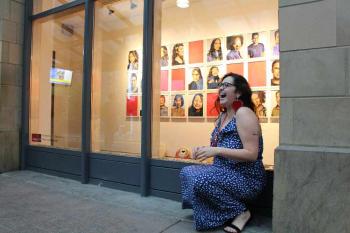Image Caption
Summary
By Stephanie Joe
Windspeaker.com Contributor
The City of Calgary Public Art Program invited Niitsitapi youth Dannielle (Danni) Black to showcase her work for a two-month long residency from July through August at the Centre Street Train Station.
She was chosen, along with two other Indigenous artists—Marina Crane from Tsuut’ina and Sheldon First Rider from the Blood Tribe—by a selection panel for the residency.
Danni’s installation showcases 22 Indigenous youth ranging from five years old to people in their mid-30’s. Danni had a team come in and take each person’s headshot, along with providing professional makeup and hair services. Her installation was meant to showcase Indigenous youth as they are today.
The headshots are presented gallery style and peppered with solid red frames, which Danni said are representative of murdered and missing Indigenous women and girls and two-spirit people.
Before she came up with her idea for the art installation, Danni needed to do some research, so she went into interview mode.
Danni said she interviewed adults before landing on the youth to showcase in her installation, focusing specifically on the youth’s relationship to language while growing up in an urban setting.
“A lot of the people that I did interview were adults, but the couple youth that I interviewed blew me away,” she said. “They were so proud of who they were.”
As an adolescent, Danni was not accustomed to being proud of who she was because she didn’t see people like her and she experienced a lot of racism towards Indigenous people in Calgary. This caused her to step back from her Indigeneity until recently.
“I’m Indigenous,” she said, “and when I started saying that, I was a little nervous to see how people would react.”
From there she started to educate herself on Indigenous issues, so she could become a spokesperson for those who wanted to listen.
“And people wanted to listen,” said Danni. “I realized that I had a voice and people wanted to listen to what I had to say and there was so much power in that.
“I wanted to give opportunities to other youth to be able to amplify their voices as well because they need to be heard.”
Danni drew a lot of inspiration from the youth she interviewed for her residency project. One youngster in particular stood out to her.
“We had this 10-year-old who was like, ‘just be proud of who you are’,” she said. “There’s so much in that statement. It’s amazing to see these youth really take on that and be happy with who they are.
“A lot of my inspiration was just showcasing how beautiful, confident, powerful, and amazing these youth are and putting that on the streets of downtown Calgary for people to see.”
She admits that she isn’t trying to break down stereotypes with her installation, but she feels the installation does just that because people aren’t used to seeing Indigenous people or youth the way they are presented in her installation—as real people.
“I think there’s a huge shift in how society is seeing Indigenous people and how we’re seeing ourselves,” she said. “I really do think the leaders are the youth.
“Once you start creating a platform for them, then you’re hearing these incredible things and you’re hearing people talk about who they are.”
Danni feels a shift is happening in the periphery of non-Indigenous society and she feels Indigenous people have a huge part to play in causing that shift.
“I very much want to be a part of it,” she said. “I think that when a person decides that they are going to be unapologetically who they are as an Indigenous person, that brings this immense power.”
“I think it’s going to take time and effort, but we’re still in that time of truth and I do believe we’ll come to reconciliation.”
She added that the word reconciliation is a broad and vague term, but she believes reconciliation happens within each person.
“I think that as long as we support our youth and our artists, we’re going to continue seeing more change and more embrace of what it means to be Indigenous.”
“We’re all connected and that includes non-Indigenous people. Because we’re inviting of other people coming onto this land but having the expectation to learn what it means to be a person of that land and how to respect it and respect each other.”
Erin Black, Danni’s mother, says she’s very happy and proud of her daughter, but admits that Danni hadn’t experienced or learned about her Indigenous culture through her mother.
“I would encourage her, whereas when I was growing up it was discouraged for me to even be curious [about my spirituality]” said Erin. “It wasn’t something that I grew up with.”
“I respect that she does this and that she seeks out people and is learning,” said Erin. “She has so much more knowledge than I’ve ever had.”
The installation is available to view now at the Centre Street Train Station located on Centre Street and 7th Avenue SE.

